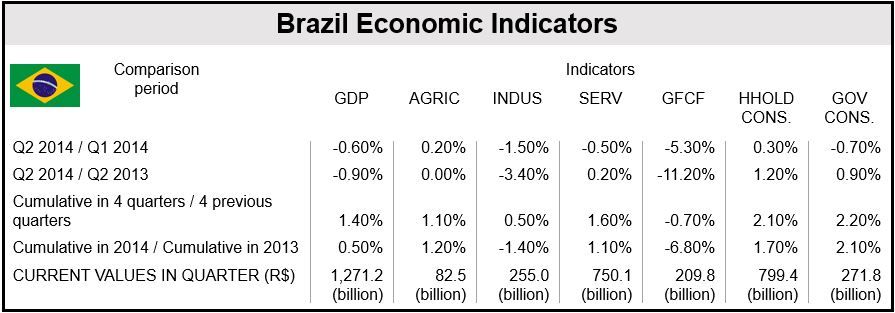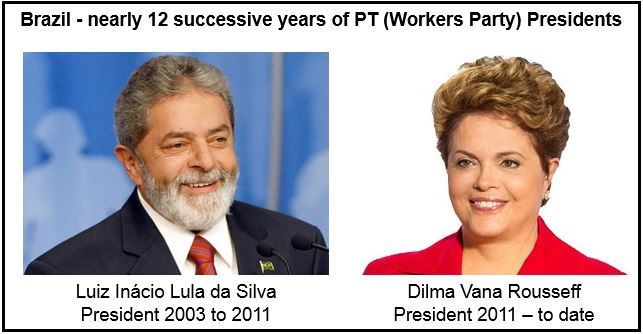In what is becoming the country’s worst year since the 2008 financial crisis, Brazilian GDP shrank by -0.6% in Q2 2014 from the first quarter. Compared to the second quarter of 2013, the economy was -0.9% smaller in Q2 this year.
A revised estimate by The Statistics Institute (IBGE) in Brazil showed that the economy in the first quarter contracted by -0.2%.
Sharp interest-rate rises by the Banco do Brasil (the country’s central bank) have undermined growth while doing virtually nothing to bring down the inflation rate for which they were intended.
Recession?
So, was Brazil officially in recession during H1 2014? A country is in recession when it experiences two consecutive quarters of GDP contraction.
The São Paulo newspaper, Folha de São Paulo, quoted Silvia Matos, an Economist who works at the Fundação Getulio Vargas, who said that two quarters of GDP contraction do not necessarily mean the country has slid into recession, because the declines were moderate (especially in the first quarter, which was revised), and unemployment showed no indication it was rising.
2014 GDP growth looking less likely
According to the most recent Banco do Brasil’s survey of 100 economists, the economy is forecast to grow by 0.7% for the whole of 2014. It would mark the worst year since 2009, when GDP shrank by -0.2%.
A careful look at the fundamental components of the economy makes one wonder whether it will manage to produce any growth at all this year.
President Dilma Vana Rousseff has attempted to bolster growth with a series of tax cuts and billions in credit and higher social spending, all apparently to no avail.
Presidential elections on October 5th
With the following data haunting President Rousseff, many are starting to comment that October’s general elections may not be that easy for her:
- Declining consumer confidence,
- dwindling industrial output,
- high interest rates,
- above-target inflation,
- an economy in recession.
Compared to her predecessor, President Luiz Inácio Lula da Silva, Rousseff’s achievements have been mediocre. GDP growth under the Rousseff administration has average less than 2% annually, the poorest result for any Brazilian leader in thirty years.
(Data Source: IBGE – Instituto Brasileiro de Geografia e Estatística. R$ = Brazilian Real)
Presidents Lula’s and Rousseff’s Worker’s Party (PT – Partido dos Trabalhadores) gained in popularity over the past 12 years. Since being in power, the party has managed to deliver the strongest GDP per capita growth in more than thirty years (most of it during Lula’s tenure), income inequality has been significantly reduced through a system of social transfers awarded to one-third of households, while unemployment reached a record low of 4.5%.
Maybe there is still enough support nationally for her party to see her through, but it must be dwindling rapidly.
As demonstrations across the country in 2013 and to a lesser extent in 2014 showed, people are becoming frustrated with mismanagement, high taxes, poor services and corruption. A recent poll reported that 70% of respondents expressed a “desire for change”.
Inflation and current-account deficit
Had the government not reduced taxes and postponed the urgently-needed gasoline and electricity price hikes, average annual inflation would currently stand at 7.5% – an almost twenty-year record.
Inflation in the services sector is more than 9% – the only area where the government has taken no measures to control prices.
One would expect a slow economy to have a small current-account deficit, but not in Brazil where it has hit a 12-year high of 3.5% of GDP. Industrial production still has to grow by 7% just to reach its pre-crisis peak in 2008.
Competitiveness has also declined. Ten years ago, manufactured goods represented 54% of exports, compared to just 37% today.
President Rousseff wants to do a second term.
Unsustainable credit growth
Even in some of the economy’s positive areas, things are starting to look much less rosy. Low unemployment and a growing services sector are both thriving on the shoulders of credit policies that are unsustainable.
The rapid growth in credit is the result of lower interest rates. However, much of this is now coming from subsidized state-owned banks. Today, 58% of lending comes from the government-owned banks, compared to about half that percentage eight years ago.
On a more positive note, Brazil’s economic outlook improved in July, according to The Conference Board. Its Leading Economic Index rose by 0.8%, while its Coincident Economic Index increased by 0.6%.



